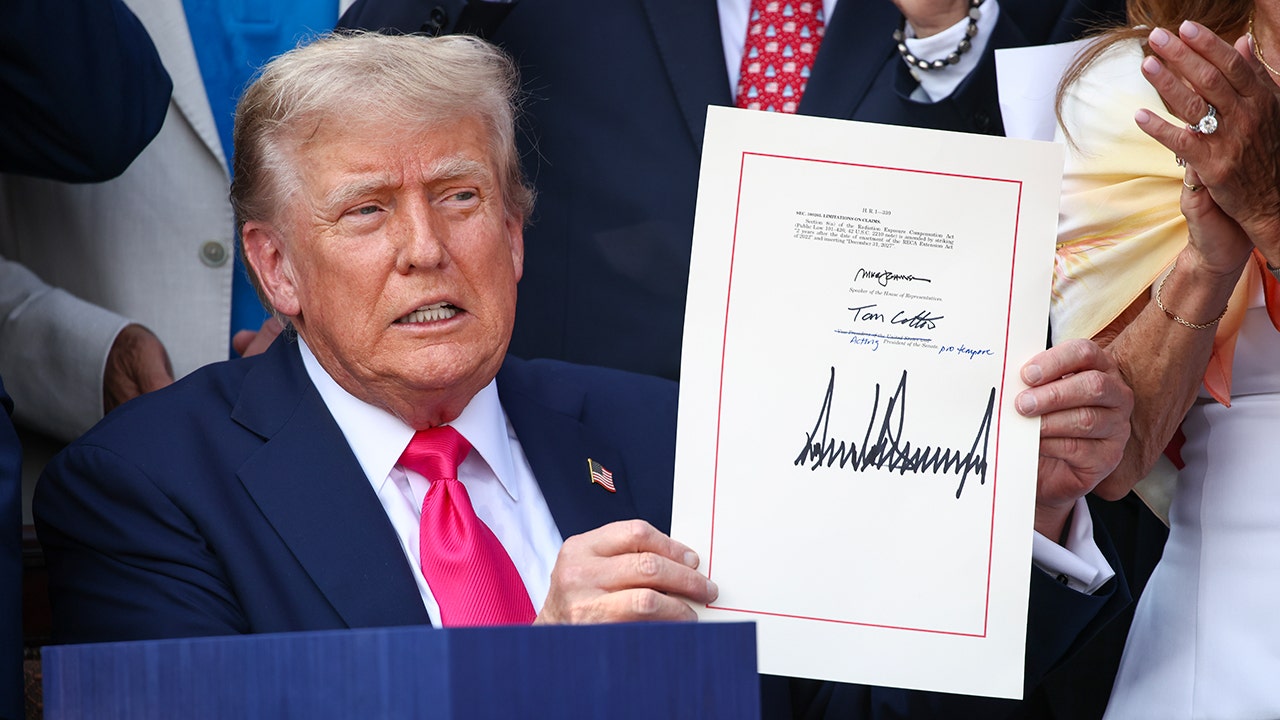Just days before Trump’s second inauguration, a massive decision was made to move the ceremony inside due to freezing temperatures in Washington, D.C. It all started with a Friday phone call from Trump to his executive producer. From there, it was 72 hours of nonstop work to figure out how to change the plans on such short notice.
The job got done thanks to a group of young members of Trump’s advance team who slept in the Capitol for days to prevent things being changed in their absence, the Daily Caller has learned.
On Thursday night, Jan. 16, then President-elect Trump called his executive producer, Justin Caporale, telling him he was concerned about the weather for the day of his inauguration. Later that night, Caporale and his team called the National Oceanic and Atmospheric Administration (NOAA) and confirmed that the weather for Monday, Jan. 20, was “dangerous and deteriorating.” They had been in touch with NOAA for about ten days prior receiving weather briefings, but that was the first time there was a real determination about what the weather would be on inauguration day.
In an exclusive interview with the Daily Caller, Caporale broke down what really happened leading up to the event and detailed his conversations with Trump surrounding the last-minute switch. Despite some grandiose plans for Trump’s swearing-in ceremony, such as the first ever flyover of the U.S. Capitol during an inauguration ceremony that would have included eight F-16’s, Trump’s team is happy with how the event ultimately turned out.
“We were looking at [it] two weeks out, contemplating if it was going to be 40 and raining,” Caporale recalled. “All of a sudden, in the span of like two days, the weather shifted … we were then looking at temperatures close to zero.”
“It was Thursday … when the president called me and said, ‘Hey, the weather’s not looking great. We have to move this thing inside. It’s going to be dangerously cold.’ And he wasn’t wrong when he said that,” Caporale said.
People attend the Inauguration of U.S. President-elect Donald Trump in the Rotunda at the U.S. Capitol on January 20, 2025 in Washington, DC.(Photo by Andrew Harnik/Getty Images)
Right after that phone call from Trump, Caporale said, “We immediately pulled our teams together” and got to work.
“In the back of our minds we’d always had weather contingency plans. But up until 72 hours before, we didn’t need them. So we pulled everybody together and the president asked, ‘What are my options?’ And obviously, two options presented themselves, which was one, to do it in the Rotunda, or two, to do it in Emancipation Hall.”
Caporale presented Trump those options, and Trump opted to do it in the Rotunda: “Obviously beautiful, ornate setting, gorgeous photos, and just felt way more appropriate than doing it in the Capitol Visitor Center,” Caporale noted.
“I asked [Trump], let’s give it 12 more hours, everything can change in 12 hours,” Caporale said. “We woke up Friday morning. I gave him a call and said, ‘Sir, I just got a weather briefing. This isn’t changing. I’m going to put everything in motion. And I gathered everybody together at 7:30 in the morning in the conference room: the swearing-in team, the National Mall team, the parade team, and essentially laid out my vision of, ‘Here’s how this needs to happen moving forward.’
“How the schedule needs to be readjusted, how we need to keep people safe — not only the swearing-in component of it, but the farewell, the review of the troops, other things that happened outside that we needed to now pull inside,” he explained.

President-elect Donald Trump arrives for inauguration ceremonies as U.S. Vice President-elect former Sen. J.D. Vance (R-OH) and U.S. President Joe Biden look on in the Rotunda of the U.S. Capitol on January 20, 2025 in Washington, DC. (Photo by Chip Somodevilla/Getty Images)
The Trump team’s main concern was what would happen to the tens of thousands of Trump supporters who traveled to D.C. and how could they get them all together in one place. The answer was Capital One Arena, which the Trump team told the Caller was always the backup plan for the parade. But Trump was skeptical: “What the fuck do you mean, ‘a parade inside’?” Caporale remembers the president asking him.
“I walked him through that I’ve already extended the contract for Capital One arena. That was always our weather backup plan anyway for the parade. So I did suggest to him that we were going to host a viewing party there … I was confident I could fill it with 20,000 people,” Caporale said. (RELATED: ‘No One Cares’: Anti-Trump Inauguration Day Protests In DC Fail To Deliver)

Attendees applaud U.S. President Donald Trump on the day of his Presidential Inauguration at the Rotunda of the U.S. Capitol in Washington, U.S. January 20, 2025. (Photo by FABRIZIO BENSCH/AFP via Getty Images)
Later Thursday night, Steve Munoz, who served as the Director of Swearing In Ceremonies, called Mike Wagner, the Joint Congressional Committee on Inaugural Ceremonies (JCCIC) executive director and gave him the heads up. Munoz and Trump’s advance team had the goal to create a grand show, upholding the ritual of the inaugural, but were met with some complications from JCCIC over the next few days. For example, JCCIC was pushing back on the height of the stage and wanted to put Trump on a one foot stage, which the Trump Team believes would have been bad optics and would see him lost in the crowd. The Trump team pushed for a three foot stage instead. JCCIC also originally only had six seats on stage in their planning map, which was obtained by the Caller. Those plans quickly changed after Trump’s team got involved.

(DAILY CALLER OBTAINED/ORIGINAL ROTUNDA STAGE PLANS)
Another issue Trump’s team ran into with JCCIC was the review of the troops inside of Emancipation Hall. Sources tell the Caller that JCCIC wanted to cancel the review of the troops and that the Trump team had to argue and negotiate with JCCIC to say it can be done. JCCIC’s main concern was that there wasn’t enough space in Emancipation Hall and that troops would not be able to march through. (RELATED: Trump Supporters Who Descended On DC Aren’t Buying The Cold Weather Excuse For Moving Inauguration)
“It was Steven Munoz. Steven Munoz should get credit in this story as the director of the swearing in ceremony, because if it wasn’t for him, a lot of this would not have happened,” Caporale explained. “He was the one that put together these diagrams, went out there with the tape measure and did not stop, because … it was important to the president.”
JCCIC ultimately fell in line once Trump’s team got the military on board with the new plans, sources said. JCCIC did not respond to a request for comment from the Daily Caller.
Worried that JCCIC might move around or change things once Trump’s team were out of sight, members of the president’s staff chose to remain in the Capitol until inauguration day. Speaker of the House Mike Johnson gave them permission to sleep in his office — which is right outside of the Rotunda — and gave them space to work leading up to Jan. 20. Trump’s team was sleeping on couches and floors in the Speaker’s office and conference rooms to ensure Trump’s vision was executed and that there were no complications.
“Wearing pajamas in the US Capitol was surreal—but walking the vacant halls of one of the most important buildings in the world was truly a sobering experience,” Joshua Sedore, the Director of Capitol Movements for the Inauguration, told the Caller.

(DAILY CALLER OBTAINED/TRUMP STAFFER SLEEPING IN CAPITOL AHEAD OF INAUGURATION)

President Donald Trump attends his inauguration in the U.S. Capitol Rotunda on January 20, 2025 in Washington, DC. (Photo by Kenny Holston-Pool/Getty Images)
Caporale told the Caller that he was with Trump all day — “literally by his side from that morning at St John’s through the inaugural balls” — and that Trump and first lady Melania Trump were “extremely happy” with how the ceremony turned out.
“[Trump] was very, very proud of that Rotunda. And he thought it was beautiful and gorgeous and it worked. And his stance now is that every president should be inaugurated in the Rotunda. It saves an incredible amount of money by doing it that way. It saves incredible amounts of manpower by doing it that way. And I mean, it showcases, you know, one of the crown jewels of our country’s political system,” Caporale said.
Read the full article here









![‘This Is A Red Line, Unspeakably Frustrating’ [WATCH] ‘This Is A Red Line, Unspeakably Frustrating’ [WATCH]](https://www.lifezette.com/wp-content/uploads/2025/05/2025.05.05-07.09-lifezette-68190cfa7ab47.jpg)


